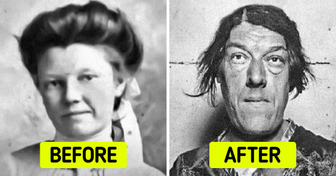The Tragic Story of a Mother Who Sacrificed Her Beauty to Save Her Children

The sinking of the Titanic in 1912 is considered one of the worst maritime disasters in history, resulting in the loss of over 1,500 lives. Despite the numerous adaptations, James Cameron’s 1997 film Titanic remains the most memorable and iconic depiction of the tragedy. The film boasts visually stunning effects, a captivating love story, and compelling characters that have left an enduring impact on popular culture.
When the director of this film, James Cameron, was writing the script, he intended the main characters to be completely fictional, but later discovered that there was a real J. Dawson on the ship, who died on board. Joseph Dawson was an Irishman who was born in 1888. On the Titanic, he was in charge of bringing coal to the workers who were in the furnaces, as well as making sure that the piles of this material were correctly distributed to maintain the balance of the ship.
Edward Smith, who grew up in an ordinary family and left school at 12 to join the Royal Naval Reserve, was the 62-year-old captain of the Titanic. With 40 years of experience, he was the most seasoned captain in the White Star Line company. The ill-fated voyage on the Titanic was intended to be Smith’s final one before retiring.
During that time, there was a common belief that icebergs posed no real threat. In 1907, the future captain of the Titanic stated in an interview that he couldn’t “conceive of any circumstance” that would lead to a ship’s sinking, as modern shipbuilding had surpassed that. There are conflicting accounts about the captain’s final moments, but some witnesses maintain that he perished heroically.
Joseph Bruce Ismay was the chairman and head of the White Star Line company. He wanted to beat his competitors, so he built a ship that was really luxurious which is why he ordered a reduction in the number of lifeboats on the ship from 48 to 16.
After he survived the wreck, Ismay was savaged by both the American and the British press for deserting the ship while women and children were still on board. And even though the official investigation proved that Ismay helped a lot of passengers and took a free seat on the last lifeboat, he had to live his life being known as a coward.
The negative image of Ismay is also carried on in the cinema. James Cameron’s film wasn’t an exception. When the history consultant asked the director to reconsider the character, it was said that the script wouldn’t be changed under any circumstances and the viewers would like to see this character in this light.
Margaret Brown, who loaned Jack a suit from her son for a dinner with aristocrats, was a genuine passenger on the Titanic. She was a philanthropist, public figure, and activist who always had others’ best interests in mind. During the ship’s sinking, Margaret assisted passengers in boarding the lifeboats and refused to board one herself. Later, she argued with the lifeboat’s commander, urging him to return to the wreckage site and rescue any remaining survivors.
After the survivors were rescued by the Carpathia, Margaret compiled lists of the survivors and searched for food and blankets for them. She established a committee to gather funds and provide psychological support for the survivors. For her efforts, Margaret was awarded the National Order of the Legion of Honor and earned the nickname "The Unsinkable Molly Brown.
Thomas Andrews was the constructor of the Titanic and he went on the first cruise to see how it functioned. After the crash, Andrews was one of the few people that knew the ship would definitely sink.
He convinced the passengers to get into the lifeboats, he searched through the rooms to make people wear life vests and go out on the deck. Andrews didn’t survive. He was last seen a short time before the ship sank. Andrew was throwing chairs from the deck into the water hoping that people would be able to use them as rafts.
William Murdoch had 16 years of experience in cruises and he was the first assistant to the captain on the Titanic. He was the officer on duty on the day of the crash, but the iceberg was spotted too late and 37 seconds later, the crash happened.
The complicated and controversial character in Cameron’s film made his nephew really angry. The creators of the film went to the motherland of the seaman and apologized to his relative and also donated money to a charity fund of his name.
Charles Lightoller was the second assistant to the captain on the Titanic. When the ship started to sink, the officer jumped off the ship. He climbed into a lifeboat with 29 other men. Lightoller taught them to keep the boat balanced and to not let it sink. Not everyone could wait long enough for the rescue ship: some just fell into the water because of exhaustion.
Lightoller was the senior officer of all the survivors and, after the tragedy, he made a lot of recommendations for cruise safety. He insisted on increasing the number of lifeboats, he recommended making booklets for training on how to use them, maintaining contact radio connection with every ship, and broadcasting signals about dangerous weather conditions.
On the night of the Titanic tragedy, Frederick Fleet and his colleague were manning the lookout, and Fleet was the first to spot the iceberg. During his questioning by the American and British commissions, Fleet stated that the lookout officers did not have binoculars. However, he believed that if they had, they “might have seen it a bit sooner” (referring to the iceberg).
Nonetheless, some experts suggest that even with binoculars, the iceberg may not have been visible in time to avoid the collision. Fleet ultimately ended up on the same lifeboat as “The Unsinkable Molly Brown” and survived the disaster.
On the day of the tragedy, Jack Phillips, the wireless officer, had a lot of telegrams from the passengers because the radio was broken the day before. Phillips was so tired that he didn’t even give the captain several warnings about the icebergs from other ships. Phillips didn’t even listen to the full message that could have helped avoid the collision because it wasn’t marked as “important.”
When the collision happened, the captain ordered all the officers to send SOS-signals. And Jack Phillips didn’t stop the broadcast until the room was filled with water and the radio wasn’t functioning anymore. Phillips didn’t survive the tragedy. Harold Bride, who worked with him, remembered that he was amazed by looking at Phillips doing his job when everyone around was in a panic. He said that he would never forget his work in his last minutes.
Archibald Gracie IV, a first-class passenger on the Titanic, was a writer and amateur historian. When the ship collided with an iceberg, he assisted Charles Lightoller in helping women and children board the lifeboats. Gracie managed to save himself by climbing onto an overturned boat after the ship sank. Upon returning to New York, he wrote a book about his experience on the Titanic, which later became a significant source of information for historians and researchers.
Unfortunately, Gracie’s health was severely affected by hypothermia, and eight months later, he died due to complications from diabetes. His last words were a reflection of his preoccupation with the sinking of the Titanic: "We must get them into the boats. We must get them all into the boats.
The scene in the film where, despite all the panic on the sinking ship, the orchestra kept on playing music moved everyone. This episode is based on true events. Wallace Hartley was the head of the orchestra on the ship and after the crash with the iceberg, Hartley and other musicians wanted to keep the passengers calm, so they started playing music.
Many witnesses claimed that the orchestra continued to play until the ship sank. None of the musicians survived. Hartley’s body was found with his violin attached to it, and there was a note on the back that said, “For Wallace on the occasion of our engagement, from Maria.”
The scene from the film where an elderly couple is hugging during the sinking of the Titanic is unforgettable. And these characters have prototypes — Ida and Isidor Straus. The spouses really loved each other. And when the businessman and politician Isidor had to be away because of work, they sent each other letters every day.
The officer of the Titanic, considering the age of the couple, was ready to let them both sit in the lifeboat. But Isidor refused because he decided to do what other men on the ship did. He tried to put his wife into the boat, but Ida didn’t want to abandon her husband on the sinking ship. Ida said, “We have lived together for many years. Where you go, I go.” The elderly couple was last seen standing arm in arm on the deck.
All we know is that they lost their lives on the ship but stayed together until the very end. After the sinking, Isidor’s body was found, and he was buried at Woodlawn Cemetery in the Bronx, New York. His wife’s body was never recovered but she was offered a memorial attached to his grave.
Seeing the real faces of the people who inspired the characters in Titanic can intensify our emotional connection to the catastrophic event that etched its mark in history. The film is renowned for its exceptional depiction of the sentiments of those aboard, rendering it one of the most iconic movies globally.











